 There are no guarantees in business. On the other hand, no CEO should take wild chances or gamble with success, especially when an easy trifecta for success is attainable. Once you’ve reached the ivory tower where CEOs lives, life is smooth sailing right? Not exactly. When you were working hard to reach this plateau, you probably only had one boss. Now you may have six or 12 depending on the size of your Board. You probably had people to manage. Now, however, you inherit an executive team to help you bear the burdens of leadership that has more power and input than people you were managing. Now the stakes are higher and getting them all on the same page, may prove to be a challenge. You can bet that one or two of them wanted the CEO position and may prove to be difficult. Maybe at least one thinks you’re not the right person for the job. Others may just want to hang onto their hands or jobs, and hope you don’t come in wielding an ax. Whether you’re a new or seasoned CEO, an article in HBR provides information for the Ace up your sleeve.
There are no guarantees in business. On the other hand, no CEO should take wild chances or gamble with success, especially when an easy trifecta for success is attainable. Once you’ve reached the ivory tower where CEOs lives, life is smooth sailing right? Not exactly. When you were working hard to reach this plateau, you probably only had one boss. Now you may have six or 12 depending on the size of your Board. You probably had people to manage. Now, however, you inherit an executive team to help you bear the burdens of leadership that has more power and input than people you were managing. Now the stakes are higher and getting them all on the same page, may prove to be a challenge. You can bet that one or two of them wanted the CEO position and may prove to be difficult. Maybe at least one thinks you’re not the right person for the job. Others may just want to hang onto their hands or jobs, and hope you don’t come in wielding an ax. Whether you’re a new or seasoned CEO, an article in HBR provides information for the Ace up your sleeve.
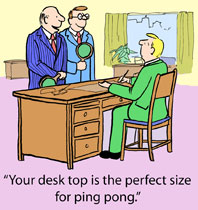 Imagine the sound of a ping pong ball falling on a hard surface. It bounces, bounces, bounces some more, and faster as it bounces away, and then bounces again, and then stops until someone picks it up and either bounces it again, or puts it in play. The phrase, “We need to…” is like that. You can insert whatever ending you like. It might be, “We need to get the roof repaired.” “We need to change that policy.” “We need to ensure we mesh our cultures.” Now imagine a CEO making such a statement to the executive team. “We need to make sure that before this merger, our two companies understand each other’s culture,” for example. What happens next? Bounce, bounce, bounce.
Imagine the sound of a ping pong ball falling on a hard surface. It bounces, bounces, bounces some more, and faster as it bounces away, and then bounces again, and then stops until someone picks it up and either bounces it again, or puts it in play. The phrase, “We need to…” is like that. You can insert whatever ending you like. It might be, “We need to get the roof repaired.” “We need to change that policy.” “We need to ensure we mesh our cultures.” Now imagine a CEO making such a statement to the executive team. “We need to make sure that before this merger, our two companies understand each other’s culture,” for example. What happens next? Bounce, bounce, bounce.
Well that’s the question, isn’t it? When anyone makes such a statement what is the expectation? Is the one asking the question going to do it? Is the listener supposed to do the action? You know you’ve made such a statemen; and I’m sure you’ve heard it from someone.
 One of the biggest laments for CEOs is that their people don’t think for themselves. Think about it. If you have several or even one team member who incessantly comes to you with questions instead of solutions your day is full of constant interruptions and productivity falls to zero – for both you and your team member. For the CEOs, the ideal is to have people think for themselves thus freeing up time for them to work on larger business issues. Why can’t or won’t people think for themselves?
One of the biggest laments for CEOs is that their people don’t think for themselves. Think about it. If you have several or even one team member who incessantly comes to you with questions instead of solutions your day is full of constant interruptions and productivity falls to zero – for both you and your team member. For the CEOs, the ideal is to have people think for themselves thus freeing up time for them to work on larger business issues. Why can’t or won’t people think for themselves?
 Do your team’s behaviors emulate the famous musketeer slogan? Can you really have such a utopian culture; or is this idea just as fictional as the musketeer story? If your company is in trouble, is the idea of creating such a team going to distract from more urgent needs? If teambuilding is the only focus – yes. We all know that when teams begin experiencing disruptive behaviors, it is the manifestation of a deeper issue.
Do your team’s behaviors emulate the famous musketeer slogan? Can you really have such a utopian culture; or is this idea just as fictional as the musketeer story? If your company is in trouble, is the idea of creating such a team going to distract from more urgent needs? If teambuilding is the only focus – yes. We all know that when teams begin experiencing disruptive behaviors, it is the manifestation of a deeper issue.
Logic tells us that handling important business issues is imperative. However, your team can be part of that process and creating an “All for one. And one for all.” culture is achievable as is illustrated in the example of DaVita, a company that provides kidney dialysis.
 They are dreaded, awkward, often biased, and described as a necessary evil. Indeed, many companies, such as Adobe, Deloitte, and GAP have stopped giving performance reviews. Is it working? According to a new study by CEB (now Gartner) maybe not. The study posits that performance went down in companies not using performance reviews. Brian Kropp with CEB suggests that there are not too many managers who can provide good reviews without some type of rating system. With apologies to cognitive psychologists out there, perhaps this is a cognitive function. In other words, from the managers point of view, how are we to rate someone at any level without something to rate them by? Then from the employee’s point of view, how do I really know where I stand without a scale to measure myself against? Except for the Picasso’s in the world, the human mind probably doesn’t think as well in the abstract. A good question to ask is, “Have the ratings really disappeared?”
They are dreaded, awkward, often biased, and described as a necessary evil. Indeed, many companies, such as Adobe, Deloitte, and GAP have stopped giving performance reviews. Is it working? According to a new study by CEB (now Gartner) maybe not. The study posits that performance went down in companies not using performance reviews. Brian Kropp with CEB suggests that there are not too many managers who can provide good reviews without some type of rating system. With apologies to cognitive psychologists out there, perhaps this is a cognitive function. In other words, from the managers point of view, how are we to rate someone at any level without something to rate them by? Then from the employee’s point of view, how do I really know where I stand without a scale to measure myself against? Except for the Picasso’s in the world, the human mind probably doesn’t think as well in the abstract. A good question to ask is, “Have the ratings really disappeared?”
 Famed speaker and coach, Patricia Fripp, will often say, “When someone wants to give you their money, you take it!” There is also an old saying that goes, “Don’t look a gift horse in the mouth.” These phrases carry a similar message. The story of what brought the contemplation of these two phrases to mind follows.
Famed speaker and coach, Patricia Fripp, will often say, “When someone wants to give you their money, you take it!” There is also an old saying that goes, “Don’t look a gift horse in the mouth.” These phrases carry a similar message. The story of what brought the contemplation of these two phrases to mind follows.
Often when we entrepreneurs market, we will give products and services away for gifts at special events. Don’t we all just love these unexpected perks? It just so happens, that a colleague of mine, whom we’ll call Bill, spoke for an enterprise with around 15 employees. He provided one hour of complimentary coaching as one of these perks. Upon hearing him speak, several of the employees wanted to engage him in a coaching program. One of these was a person who had received a complimentary the one hour coaching perk. Bill faithfully delivered the one hour coaching and the employee told her boss, CEO of the enterprise, that it was the best hour she had ever spent.
 Christmas, Hanukah, MLK Day, and St. Patrick’s Day, and other celebrations come once a year, every year. Some of these may cost us time, money, and other resources that we invest in their celebration. We know they are coming, they are all on our calendars. So we always prepare for them. Right?
Christmas, Hanukah, MLK Day, and St. Patrick’s Day, and other celebrations come once a year, every year. Some of these may cost us time, money, and other resources that we invest in their celebration. We know they are coming, they are all on our calendars. So we always prepare for them. Right?
Business growth comes in the form of higher revenues, more customers, through mergers and acquisitions, or maybe franchising. Regardless of the growth methodology, the fact is that businesses must grow or die. Growth brings change. So, we expect change and are always prepared for it. Right?
An executive client knows his organization is engaged in aggressive growth. However, when I asked how his department might change with the next two acquisitions, all he could replay was, “That’s a good question.” Well, yes, indeed it is. The fact that the thought had apparently not entered his mind was a surprise; and it’s especially surprising given the fact that he wants to be president of the company upon the current president’s retirement. So much for planning. So how can this executive better prepare his department for growth and change?
 An executive recently complained to the superior of a fellow executive in the same company that Bob, not his real name, was often insubordinate, sat on people’s desks, flexed his muscles, and was a know-it-all. Bob’s boss replied, “Bob’s OK, he’s just weird.” The executive, a client of mine, relaying this story to me felt confused because she saw this person as being condescending, but yet couldn’t understand why she felt that way and so blamed herself. When I asked this executive if she would let her son speak to her that way, she replied, “Good grief, no!” Why is this situation any different?
An executive recently complained to the superior of a fellow executive in the same company that Bob, not his real name, was often insubordinate, sat on people’s desks, flexed his muscles, and was a know-it-all. Bob’s boss replied, “Bob’s OK, he’s just weird.” The executive, a client of mine, relaying this story to me felt confused because she saw this person as being condescending, but yet couldn’t understand why she felt that way and so blamed herself. When I asked this executive if she would let her son speak to her that way, she replied, “Good grief, no!” Why is this situation any different?
It just so happens that my client has her eyes on the CEO position when the current CEO retires in a few years. If Bob’s behavior is allowed to continue, do you think he will stop just because this person is now the CEO? Bob will take great pride in his ability to talk to such a superior in this manner, belittle the now CEO, behind her back of course, and generally help lace the organization’s culture with this condescending behavior company wide. The behavior now becomes accepted and the norm. What’s a budding CEO to do?
 In his book, The Personal MBA: Master the Art of Business, Josh Kaufman describes a phenomenon he calls “bystander apathy.” In essence, Mr. Kaufman suggests that any project without a leader won’t get completed. He cites committees as a perfect example, as they often do not have a leader and a project can linger inside a committee literally for years. Your organization’s strategic plan can be met with the same fate without accountable leadership.
In his book, The Personal MBA: Master the Art of Business, Josh Kaufman describes a phenomenon he calls “bystander apathy.” In essence, Mr. Kaufman suggests that any project without a leader won’t get completed. He cites committees as a perfect example, as they often do not have a leader and a project can linger inside a committee literally for years. Your organization’s strategic plan can be met with the same fate without accountable leadership.
Many leaders believe that change needs to involve everyone, and that’s a good thing. However, handing responsibility for that change off to everyone or anyone besides the executive team is not so good. Change begins at the top. Further, executives must be involved and held accountable throughout the change process. Much of this begins when developing the strategic plan.
 Those on executive teams often have goals and ambitions to be the CEO of the organization. You may be such an individual. Once a speaker colleague was trying to decide what to speak about to a group. She made this comment, “I don’t know if these people even have dreams.” My head spun around about 3600. What? Everyone has dreams. But even some executives will sell their own teammates short thinking that they are the only one on the team with the CEO dream. Nothing could be further from the truth. This is dangerous territory. Why?
Those on executive teams often have goals and ambitions to be the CEO of the organization. You may be such an individual. Once a speaker colleague was trying to decide what to speak about to a group. She made this comment, “I don’t know if these people even have dreams.” My head spun around about 3600. What? Everyone has dreams. But even some executives will sell their own teammates short thinking that they are the only one on the team with the CEO dream. Nothing could be further from the truth. This is dangerous territory. Why?
When considering that you are the only one with ambitious goals, you may well have slumped into complacency not to mention being a bone head. Sorry, it had to be said. This type of thinking tells me that both you and my colleague have no empathy for or are not reading the pulse of others, even the ones on your own team. Everyone has dreams of some sort. Maybe they aren’t the dream of becoming a CEO, but they may want to use their position to obtain other dreams. If you find yourself with these types of thoughts, here are some ideas to help get you back on track.

The road to becoming a CEO is long and arduous. People looking to become CEOS often begin developing valuable characteristics early in life. Around age 13, Bill Gates began racking up 10,000 hours learning to program on a high school computer. Edward Lampert, of Sears, lost his father at 14 and helped support his family by working after school and on weekends while still maintaining good grades. Those striving for the top position, obtain a good education – both in and out of school. When natural skills are lacking, being willing to seek a mentor or hire a coach helps put individuals on the path to success. Preparation is key for the tough job ahead.
CEOs
 The quote in the above title, is by the singer-songwriter, Bob Dylan. Chaos can be a friend in business as well. OK, when your head stops spinning, continue reading. CEOs start businesses because they are good at something. They think they can do something better than others. Or, they see a need in the market and fill that need. The point is that there are a myriad of reasons people start their own business. However, a new business is a world of struggle.
The quote in the above title, is by the singer-songwriter, Bob Dylan. Chaos can be a friend in business as well. OK, when your head stops spinning, continue reading. CEOs start businesses because they are good at something. They think they can do something better than others. Or, they see a need in the market and fill that need. The point is that there are a myriad of reasons people start their own business. However, a new business is a world of struggle.
A new business struggles to define roles, identify a target audience, refine and sometimes reinvent products and services. These are the very causes of chaos. Other causes of chaos are gossip, lack of teamwork, selfish agendas, a lack of establishing expectations and failure to manage expectations that have been established. The same chaos can occur in established organizations as well. Moving from one stage of growth to the next is another major contributor to chaos. Here are two specific times this occurs.
 Complexity and how it affects productivity seems to be the new boogie man haunting organiztions. The reality is that research by Margaret Wheatly in 1994 and Olson and Eoyang in 2001 brought this Ghoul out of its closet. Needless to say, different factors from different business issues such as technology and the world economic and political stages have added their own unique twists to the complexity of doing business. One factor that has remained constant is people. Zimmerman (1998), as quoted in a study by Peter M. Dickens states, “In every interaction, people mutually adjust their behaviors in ways needed to cope with changing internal and external environmental demands.”
Complexity and how it affects productivity seems to be the new boogie man haunting organiztions. The reality is that research by Margaret Wheatly in 1994 and Olson and Eoyang in 2001 brought this Ghoul out of its closet. Needless to say, different factors from different business issues such as technology and the world economic and political stages have added their own unique twists to the complexity of doing business. One factor that has remained constant is people. Zimmerman (1998), as quoted in a study by Peter M. Dickens states, “In every interaction, people mutually adjust their behaviors in ways needed to cope with changing internal and external environmental demands.”
I don’t know so much about the “mutually” part, but yes, as humans we either adapt or die. That’s what we do. Unfortunately, not all of us have the capability of adapting to certain situations, or we don’t adapt as rapidly as some of our teammates, or we fail to see the reason to adapt. Others fail to anticipate a change is in the works and get broadsided by the change. Then there are those who simply don’t want to adapt. Ahhhh, I can see you are already reading between the lines…human behavior can add to the complexity of business.
Behavior at the individual level plays a major role in business complexity. The factor that adds to the complexity at the individual level is that many CEOs fail to see this blind spot, fail to understand it, and therefore, fail to manage it. Where does complexity on an individual level manifest? A case study by McKinsey and a “heat map” generated from their research, indicates both the intensity of complexity as well as ferreting out individual causes. Some of these are

No organization is free of conflict at any level. Not even at the home of the most famous mouse in the world, Walt Disney and not even at the highest levels of leadership. In fact, so much conflict was taking place at Disney when Michael Ovitz, a Disney Director and the CEO, Michael Eisner were experiencing major clashes that Ovitz was terminated and a court case ensured. The financial cost was $140 million for Ovitz’s severance package and legal fees on top of that. So much for fairy tales.
As a CEO or manager, the trick is knowing if and when to step in to settle situations. An even better tactic is prevention.
 As a “recovering” Human Resources professional, working in hotels no less, I’ve had my share of difficult conversations with both guests and employees. Conversations with employees ranged from body odor, to inappropriate dress, unprofessional behavior, rule infractions, personality conflicts, petty territorial disagreements, and you name it. While some workplace conversations can be difficult, avoiding them is not recommended. First, we’ll look at the consequences avoiding difficult conversations can bring and then look at the essential steps for handling them.
As a “recovering” Human Resources professional, working in hotels no less, I’ve had my share of difficult conversations with both guests and employees. Conversations with employees ranged from body odor, to inappropriate dress, unprofessional behavior, rule infractions, personality conflicts, petty territorial disagreements, and you name it. While some workplace conversations can be difficult, avoiding them is not recommended. First, we’ll look at the consequences avoiding difficult conversations can bring and then look at the essential steps for handling them.
Some people think that because an individual holds a managerial position that he or she automatically understands how to handle difficult conversations. Further, while managers may think they are confident and competent at holding difficult conversations, Human Resources (HR) holds a different opinion as indicated in the graph below.
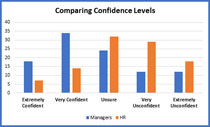
Source:Adapted from Handling Difficult Conversations at Work
Well certainly a CEO knows how to chew these conversations up and spit them out. The fact is, that most of us don’t enjoy holding these conversations and many of us are not that skilled at having them. In fact, according to a study appearing in a Sage Publication, these conversations can be unnerving and emotionally draining. So, as human nature dictates, we avoid the unpleasant and the awkward. Failing to hold training sessions for difficult conversations is only asking for trouble.
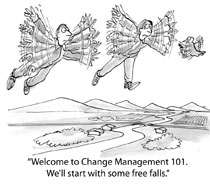 Many people will resist change to the nth degree. Others will not only embrace it, but cause it to happen just for the fun of it. Whatever your preference when it comes to change, change itself at least in the corporate world, is itself, changing.
Many people will resist change to the nth degree. Others will not only embrace it, but cause it to happen just for the fun of it. Whatever your preference when it comes to change, change itself at least in the corporate world, is itself, changing.
Organizations in general are beginning to understand that change management needs to be a required core competency. Therefore, if you are one of those team members who doesn’t deal well with change, you will need to ramp up your ability to handle and implement change at a higher level of expediency.
The CEO’s Role: CEOs, specifically, are also beginning to recognize the importance of their role in change management. As an example, a recent client wanted to change the bank’s culture to a sales culture. After meeting with a member of the client’s team, and then checking back in a couple of weeks later, I was informed that the bank had decided to roll out this change initiative beginning with the tellers and the CSRs (customer service reps). What I wanted to do would have landed me in prison. Rather, I chose the more professional, but very direct route, of suggesting to the team member that would prove disastrous for the change initiative. You see, while the tellers and CSRs do have a lot of customer contact, they are not the place to initiate a culture change.
DID YOU KNOW THAT THE FAILURE RATE FOR NEW MANAGERS IS *46%!?
Why was the First Time Managers Coaching Program Created?
As a former manager in human resources, witnessing the promotion of unqualified people to management was heartbreaking. And the failure rate was proving costly. As an executive coach, I can see these failures manifest when there is a lack of solid leadership training.
New managers rarely have the training they need, and certainly don’t have any of the experience an executive possesses. Indeed, most new managers are promoted primarily because they are doing a good job in their current position. That doesn’t necessarily make them management material.
The executive staff are the people who get the resources such as training, off-site retreats, and coaching. Of course, it is a good idea to put resources behind the executive staff because, after all, they are carrying a lot of risks for the success of the organization.
But think about this. New managers are the people who could one day fill the shoes of an executive in your organization. I dare say that any executive you speak with wishes he or she had more “care and feeding” about how to manage and lead as they started up and continued to climb the ladder into the executive suite.
That’s why I’ve created a coaching program specifically designed for managers with zero to three years’ experience. This program is affordable, so the organization can not only justify, but recoup the investment, and reap benefits the company will profit from for years to come.
Schedule an Appointment
How does the First Time Managers Program Work?
The new manager takes the TriMetrix HD Assessment, and receives a report consisting of:
- Behaviors:

Behavioral research suggests that the most effective people are those who understand themselves, both their strengths and weaknesses, so they can develop strategies to meet the demands of their environment. This report measures the four dimensions of normal behavior: dominance, influence, steadiness, and compliance.
TriMetrix HD tells how the new manager will perform.
*Source: HR.com
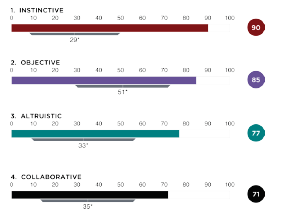 Knowledge of an individual’s driving forces helps tell us why a person behaves a certain way. 12 Driving Forces ™ measures an individual’s top four of driving forces to tell a story of how a person derives meaning from life and work.
Knowledge of an individual’s driving forces helps tell us why a person behaves a certain way. 12 Driving Forces ™ measures an individual’s top four of driving forces to tell a story of how a person derives meaning from life and work.
TriMetrix HD illuminates what drives this individual’s behavior – the why behind their actions.
- Competencies:
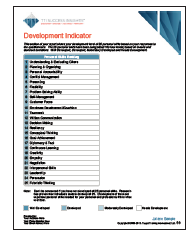
An individual’s hierarchy of competencies, including his/her leadership score, is key to their success. Knowing what they are is essential to reaching one’s goals. This report is designed to assist managing and developing a career. For many jobs, personal skills are as important as technical skills in producing superior performance.
TriMetrix HD describes what this individual “has done” in 25 research-based competencies related to the business environment.
Acumen Capacity Index:

The Acumen Indicators section is designed to help individuals truly understand themselves and how they analyze and interpret their experiences. A person’s acumen, keenness, and depth of perception or discernment is directly related to performance.
TriMetrix ACI explores both how a person’s judgment impacts interaction with the external world, and his or her own self-perception.
In addition, the assessment reports contain self-coaching strategies that will guide the new manager beyond the coaching initiatives of this program.
Schedule an Appointment
Program Structure
Online assessment administration
3 months or 12 hours of coaching (Bonus: 1 extra hour at no charge in the first session!)
Unlimited access to the coach via phone and email during the coaching program
The Program is Designed To:- Increase clarity, focus, and direction
- Create a specific strategy and a plan to reach goals
- Build or enhance necessary skills
- Create a supportive environment to achieve success
- Deal with barriers that block goal achievement
Coaching Topics Include, but Are Not Limited To:
- Leadership myths and magic
- Understanding roles and responsibilities
- Critical/strategic thinking
- Handling relationships (former peers and supervisor)
- Understanding your team’s history
- Understanding performance management
- Communication
- Problem analysis and decision making (including making hard decisions)
- Creating a culture of accountability
- Motivating your team
- Coaching
- Evaluating your team
- Continuous learning and trends
Why am I Qualified to Coach?
- Ten years of coaching executives from a variety of industries across the United States and from Israel, Chile, South America, Japan, Germany, China, and Sweden.
- Certifications include: Registered Corporate Coach (RCC), Leaders Coaching Leaders Coach (LCL) and Facilitator, Certified Professional Driving Forces Analyst (CPDFA); (CPBA); (DISC Certified); Certified TriMetrix HD Analyst (CPHDA), and Certified Professional Emotional Quotient Analyst (CPEQA)
- Formal education includes a Masters of Arts in Industrial Organizational Psychology and a Bachelor of Science in Psychology
- Six years as a Human Resource Manager
Bonus I:
One complimentary extra hour of coaching in the first session, for a total of 14 hours of coaching.
Bonus II:
Diane’s eBook, How to Give Dull, Boring Meetings a Swift Kick in the Agenda. This book provides the new manager with insights on:
- How to manage different behavioral styles in meetings
- How to determine if a meeting is necessary
- Types of meetings
- How to have more effective meetings
- Ways to make meetings fun!
Bonus III:
A complimentary “check-in” call 3 months after our final session to help ensure the new manager is still on track. This brings the total number of coaching hours to 15!!
Let's get started to give your managers the leadership foundation they need to make it all the way to the Executive Suite!
 An executive coaching client suggested that “everything in her company is in disarray and nothing is getting accomplished.” As I began questioning her, it was easy to understand why. Current projects for this organization include:
An executive coaching client suggested that “everything in her company is in disarray and nothing is getting accomplished.” As I began questioning her, it was easy to understand why. Current projects for this organization include:
- Restructuring a large department while finding a new leader for it
- Opening two new branches in different towns.
- Acquiring another company
- A major remodeling project at headquarters
- Preparing for a major bi-annual meeting to be held in four months
- Putting together a succession plan in anticipation of the CEO’s retirement in a few years
Not only are there several major projects in the works, the CEO often loses track of what he has told his team, who is to do what, and how much progress has been accomplished on each project. In fact, on one of the new branch openings, three people had three different opening dates as their goal.
 CEOs focus on strategy and must also ensure their organization is financially sound. There is another critical concern and that is talent. The savvy CEO is the one who understands the importance of hiring good talent, ensuring a good fit, and then continuously developing that talent. Good talent pulls organizations through the good times, tough times, major changes, and navigating a crisis. But the CEO cannot and should not take on the talent task alone. One of the major partners in the talent effort is HR. However, the CFO should also be a part of that talent task triangle. Having these two partners in place is a great benefit to the CEO.
CEOs focus on strategy and must also ensure their organization is financially sound. There is another critical concern and that is talent. The savvy CEO is the one who understands the importance of hiring good talent, ensuring a good fit, and then continuously developing that talent. Good talent pulls organizations through the good times, tough times, major changes, and navigating a crisis. But the CEO cannot and should not take on the talent task alone. One of the major partners in the talent effort is HR. However, the CFO should also be a part of that talent task triangle. Having these two partners in place is a great benefit to the CEO.
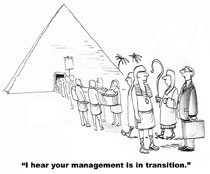 Change is rarely easy. Transitions in leadership fall into the change arena and not only is it rarely easy, a CEO transition, whether planned or unexpected, can lead to chaos if not handled with care. If there are extenuating circumstances around the transition, life can become an out of control roller coaster with a broken stop button. As with any other change, there are ways to prepare for eventualities and prevent catastrophes.
Change is rarely easy. Transitions in leadership fall into the change arena and not only is it rarely easy, a CEO transition, whether planned or unexpected, can lead to chaos if not handled with care. If there are extenuating circumstances around the transition, life can become an out of control roller coaster with a broken stop button. As with any other change, there are ways to prepare for eventualities and prevent catastrophes.
Succession Planning: Succession planning plays a large role and this responsibility falls squarely on the shoulder’s of the Board and the current CEO – unless, of course, the current CEO is going to be asked to leave prematurely. The problem is that Boards meet, at the most, monthly. Some organizational Boards meet even more infrequently. Therefore, succession planning should be on the agenda at every Board meeting. Some organizations select a hiring committee to aid in the search as well. An outside adviser or consultant can aid in the process as well. Spending a lot of time on the selection of the next CEO does not guarantee success. There are a lot of companies that make the transition successful spending little time in the effort. However, there are certain elements and processes that help every executive transition flow better.
 There are no guarantees in business. On the other hand, no CEO should take wild chances or gamble with success, especially when an easy trifecta for success is attainable. Once you’ve reached the ivory tower where CEOs lives, life is smooth sailing right? Not exactly. When you were working hard to reach this plateau, you probably only had one boss. Now you may have six or 12 depending on the size of your Board. You probably had people to manage. Now, however, you inherit an executive team to help you bear the burdens of leadership that has more power and input than people you were managing. Now the stakes are higher and getting them all on the same page, may prove to be a challenge. You can bet that one or two of them wanted the CEO position and may prove to be difficult. Maybe at least one thinks you’re not the right person for the job. Others may just want to hang onto their hands or jobs, and hope you don’t come in wielding an ax. Whether you’re a new or seasoned CEO, an article in HBR provides information for the Ace up your sleeve.
There are no guarantees in business. On the other hand, no CEO should take wild chances or gamble with success, especially when an easy trifecta for success is attainable. Once you’ve reached the ivory tower where CEOs lives, life is smooth sailing right? Not exactly. When you were working hard to reach this plateau, you probably only had one boss. Now you may have six or 12 depending on the size of your Board. You probably had people to manage. Now, however, you inherit an executive team to help you bear the burdens of leadership that has more power and input than people you were managing. Now the stakes are higher and getting them all on the same page, may prove to be a challenge. You can bet that one or two of them wanted the CEO position and may prove to be difficult. Maybe at least one thinks you’re not the right person for the job. Others may just want to hang onto their hands or jobs, and hope you don’t come in wielding an ax. Whether you’re a new or seasoned CEO, an article in HBR provides information for the Ace up your sleeve. Imagine the sound of a ping pong ball falling on a hard surface. It bounces, bounces, bounces some more, and faster as it bounces away, and then bounces again, and then stops until someone picks it up and either bounces it again, or puts it in play. The phrase, “We need to…” is like that. You can insert whatever ending you like. It might be, “We need to get the roof repaired.” “We need to change that policy.” “We need to ensure we mesh our cultures.” Now imagine a CEO making such a statement to the executive team. “We need to make sure that before this merger, our two companies understand each other’s culture,” for example. What happens next? Bounce, bounce, bounce.
Imagine the sound of a ping pong ball falling on a hard surface. It bounces, bounces, bounces some more, and faster as it bounces away, and then bounces again, and then stops until someone picks it up and either bounces it again, or puts it in play. The phrase, “We need to…” is like that. You can insert whatever ending you like. It might be, “We need to get the roof repaired.” “We need to change that policy.” “We need to ensure we mesh our cultures.” Now imagine a CEO making such a statement to the executive team. “We need to make sure that before this merger, our two companies understand each other’s culture,” for example. What happens next? Bounce, bounce, bounce. One of the biggest laments for CEOs is that their people don’t think for themselves. Think about it. If you have several or even one team member who incessantly comes to you with questions instead of solutions your day is full of constant interruptions and productivity falls to zero – for both you and your team member. For the CEOs, the ideal is to have people think for themselves thus freeing up time for them to work on larger business issues. Why can’t or won’t people think for themselves?
One of the biggest laments for CEOs is that their people don’t think for themselves. Think about it. If you have several or even one team member who incessantly comes to you with questions instead of solutions your day is full of constant interruptions and productivity falls to zero – for both you and your team member. For the CEOs, the ideal is to have people think for themselves thus freeing up time for them to work on larger business issues. Why can’t or won’t people think for themselves? Do your team’s behaviors emulate the famous musketeer slogan? Can you really have such a utopian culture; or is this idea just as fictional as the musketeer story? If your company is in trouble, is the idea of creating such a team going to distract from more urgent needs? If teambuilding is the only focus – yes. We all know that when teams begin experiencing disruptive behaviors, it is the manifestation of a deeper issue.
Do your team’s behaviors emulate the famous musketeer slogan? Can you really have such a utopian culture; or is this idea just as fictional as the musketeer story? If your company is in trouble, is the idea of creating such a team going to distract from more urgent needs? If teambuilding is the only focus – yes. We all know that when teams begin experiencing disruptive behaviors, it is the manifestation of a deeper issue. They are dreaded, awkward, often biased, and described as a necessary evil. Indeed, many companies, such as Adobe, Deloitte, and GAP have stopped giving performance reviews. Is it working? According to a new study by
They are dreaded, awkward, often biased, and described as a necessary evil. Indeed, many companies, such as Adobe, Deloitte, and GAP have stopped giving performance reviews. Is it working? According to a new study by  Famed speaker and coach,
Famed speaker and coach,  Christmas, Hanukah, MLK Day, and St. Patrick’s Day, and other celebrations come once a year, every year. Some of these may cost us time, money, and other resources that we invest in their celebration. We know they are coming, they are all on our calendars. So we always prepare for them. Right?
Christmas, Hanukah, MLK Day, and St. Patrick’s Day, and other celebrations come once a year, every year. Some of these may cost us time, money, and other resources that we invest in their celebration. We know they are coming, they are all on our calendars. So we always prepare for them. Right? An executive recently complained to the superior of a fellow executive in the same company that Bob, not his real name, was often insubordinate, sat on people’s desks, flexed his muscles, and was a know-it-all. Bob’s boss replied, “Bob’s OK, he’s just weird.” The executive, a client of mine, relaying this story to me felt confused because she saw this person as being condescending, but yet couldn’t understand why she felt that way and so blamed herself. When I asked this executive if she would let her son speak to her that way, she replied, “Good grief, no!” Why is this situation any different?
An executive recently complained to the superior of a fellow executive in the same company that Bob, not his real name, was often insubordinate, sat on people’s desks, flexed his muscles, and was a know-it-all. Bob’s boss replied, “Bob’s OK, he’s just weird.” The executive, a client of mine, relaying this story to me felt confused because she saw this person as being condescending, but yet couldn’t understand why she felt that way and so blamed herself. When I asked this executive if she would let her son speak to her that way, she replied, “Good grief, no!” Why is this situation any different? In his book, The Personal MBA: Master the Art of Business,
In his book, The Personal MBA: Master the Art of Business,  Those on executive teams often have goals and ambitions to be the CEO of the organization. You may be such an individual. Once a speaker colleague was trying to decide what to speak about to a group. She made this comment, “I don’t know if these people even have dreams.” My head spun around about 3600. What? Everyone has dreams. But even some executives will sell their own teammates short thinking that they are the only one on the team with the CEO dream. Nothing could be further from the truth. This is dangerous territory. Why?
Those on executive teams often have goals and ambitions to be the CEO of the organization. You may be such an individual. Once a speaker colleague was trying to decide what to speak about to a group. She made this comment, “I don’t know if these people even have dreams.” My head spun around about 3600. What? Everyone has dreams. But even some executives will sell their own teammates short thinking that they are the only one on the team with the CEO dream. Nothing could be further from the truth. This is dangerous territory. Why?
 The quote in the above title, is by the singer-songwriter, Bob Dylan. Chaos can be a friend in business as well. OK, when your head stops spinning, continue reading. CEOs start businesses because they are good at something. They think they can do something better than others. Or, they see a need in the market and fill that need. The point is that there are a myriad of reasons people start their own business. However, a new business is a world of struggle.
The quote in the above title, is by the singer-songwriter, Bob Dylan. Chaos can be a friend in business as well. OK, when your head stops spinning, continue reading. CEOs start businesses because they are good at something. They think they can do something better than others. Or, they see a need in the market and fill that need. The point is that there are a myriad of reasons people start their own business. However, a new business is a world of struggle. Complexity and how it affects productivity seems to be the new boogie man haunting organiztions. The reality is that research by Margaret Wheatly in 1994 and Olson and Eoyang in 2001 brought this Ghoul out of its closet. Needless to say, different factors from different business issues such as technology and the world economic and political stages have added their own unique twists to the complexity of doing business. One factor that has remained constant is people. Zimmerman (1998), as quoted in a study by Peter M. Dickens states, “In every interaction, people mutually adjust their behaviors in ways needed to cope with changing internal and external environmental demands.”
Complexity and how it affects productivity seems to be the new boogie man haunting organiztions. The reality is that research by Margaret Wheatly in 1994 and Olson and Eoyang in 2001 brought this Ghoul out of its closet. Needless to say, different factors from different business issues such as technology and the world economic and political stages have added their own unique twists to the complexity of doing business. One factor that has remained constant is people. Zimmerman (1998), as quoted in a study by Peter M. Dickens states, “In every interaction, people mutually adjust their behaviors in ways needed to cope with changing internal and external environmental demands.”
 As a “recovering” Human Resources professional, working in hotels no less, I’ve had my share of difficult conversations with both guests and employees. Conversations with employees ranged from body odor, to inappropriate dress, unprofessional behavior, rule infractions, personality conflicts, petty territorial disagreements, and you name it. While some workplace conversations can be difficult, avoiding them is not recommended. First, we’ll look at the consequences avoiding difficult conversations can bring and then look at the essential steps for handling them.
As a “recovering” Human Resources professional, working in hotels no less, I’ve had my share of difficult conversations with both guests and employees. Conversations with employees ranged from body odor, to inappropriate dress, unprofessional behavior, rule infractions, personality conflicts, petty territorial disagreements, and you name it. While some workplace conversations can be difficult, avoiding them is not recommended. First, we’ll look at the consequences avoiding difficult conversations can bring and then look at the essential steps for handling them.
 Many people will resist change to the nth degree. Others will not only embrace it, but cause it to happen just for the fun of it. Whatever your preference when it comes to change, change itself at least in the corporate world, is itself, changing.
Many people will resist change to the nth degree. Others will not only embrace it, but cause it to happen just for the fun of it. Whatever your preference when it comes to change, change itself at least in the corporate world, is itself, changing.
 Knowledge of an individual’s driving forces helps tell us why a person behaves a certain way. 12 Driving Forces ™ measures an individual’s top four of driving forces to tell a story of how a person derives meaning from life and work.
Knowledge of an individual’s driving forces helps tell us why a person behaves a certain way. 12 Driving Forces ™ measures an individual’s top four of driving forces to tell a story of how a person derives meaning from life and work.

 An executive coaching client suggested that “everything in her company is in disarray and nothing is getting accomplished.” As I began questioning her, it was easy to understand why. Current projects for this organization include:
An executive coaching client suggested that “everything in her company is in disarray and nothing is getting accomplished.” As I began questioning her, it was easy to understand why. Current projects for this organization include: CEOs focus on strategy and must also ensure their organization is financially sound. There is another critical concern and that is talent. The savvy CEO is the one who understands the importance of hiring good talent, ensuring a good fit, and then continuously developing that talent. Good talent pulls organizations through the good times, tough times, major changes, and navigating a crisis. But the CEO cannot and should not take on the talent task alone. One of the major partners in the talent effort is HR. However, the CFO should also be a part of that talent task triangle. Having these two partners in place is a great benefit to the CEO.
CEOs focus on strategy and must also ensure their organization is financially sound. There is another critical concern and that is talent. The savvy CEO is the one who understands the importance of hiring good talent, ensuring a good fit, and then continuously developing that talent. Good talent pulls organizations through the good times, tough times, major changes, and navigating a crisis. But the CEO cannot and should not take on the talent task alone. One of the major partners in the talent effort is HR. However, the CFO should also be a part of that talent task triangle. Having these two partners in place is a great benefit to the CEO. Change is rarely easy. Transitions in leadership fall into the change arena and not only is it rarely easy, a CEO transition, whether planned or unexpected, can lead to chaos if not handled with care. If there are extenuating circumstances around the transition, life can become an out of control roller coaster with a broken stop button. As with any other change, there are ways to prepare for eventualities and prevent catastrophes.
Change is rarely easy. Transitions in leadership fall into the change arena and not only is it rarely easy, a CEO transition, whether planned or unexpected, can lead to chaos if not handled with care. If there are extenuating circumstances around the transition, life can become an out of control roller coaster with a broken stop button. As with any other change, there are ways to prepare for eventualities and prevent catastrophes.